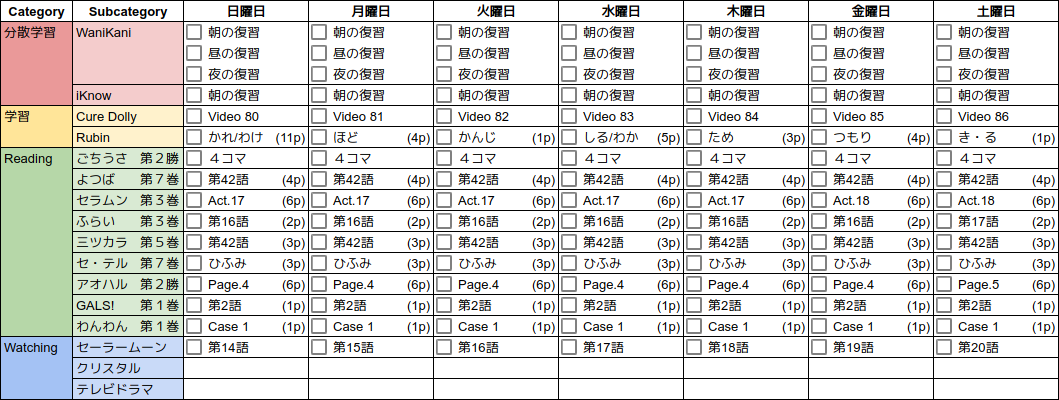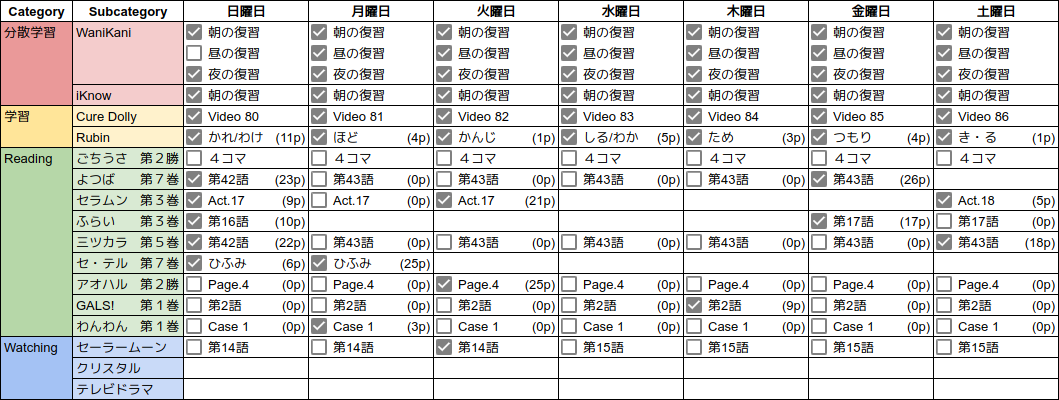WaniKani Progress
Seeing my WaniKani progress hovering at around six to eight weeks per level, I’m internally debating on whether to:
- increase my apprentice count above 100~120, and enforce doing reviews four times per day
-
pro: more lessons per day = more learned in less time = more words I’ll recognize when reading
-
con: more time spent reviewing each day = less time for other things, including reading
- spend
more any time reviewing leeches
-
pro: getting leeches figured out will reduce the apprentice count, making room for more lessons
-
con: when I’m on level 22, and a level 8 item hits apprentice 1, I have no idea what it’ll take for me to learn it = wasted time trying to figure it out
- simply accept up to two months per level; it’s not a race
-
pro: keeping apprentice at around 100, I’m able to continue my daily reviews without feeling overwhelmed
-
con: the longer it takes me to learn more vocabulary via WaniKani, the fewer words I’ll recognize when reading in the short-term
Weekly Schedule Findings
For now, I’m trying to keep up with my weekly schedule. My findings so far:
- If something doesn’t have furigana, it doesn’t matter if I set my daily reading goal to 2 pages, or even four panels. I’ll probably skip doing it. (This does not bode well for me in the upcoming Kiki book club!)
- Everything I read has a daily page count goal. I find it hard to start reading a manga (to fulfill the daily goal) if it’s something I normally read many pages in one sitting (Sailormoon, Aoharu). Then I end up having to read a lot to catch up.
- Easy-to-read manga are like dessert sitting next to a peanut butter sandwich on wheat bread and a bowl of steamed broccoli. I need to make certain I start a reading session with a dialogue-heavy manga, then go to an easy one, and then another straining one, and then another simple one.
- Trying to put anime-watching on a schedule isn’t working. Daily anime watching was so much easier to fit in back before I started SRS. (But I fit in eight episodes of classic Sailormoon today, so there is that.)
- There’s no way I would have finished my long overdue re-read of Jay Rubin’s Making Sense of Japanese without scheduling a section per day.
- There’s no way I’d have watched as much Cure Dolly as I have without scheduling one episode per day.
Latest Purchases
ふらいんぐうぃっち 第4巻
I need to check and see if I’m past the material covered in the anime, so I can give it a watch. This one would probably be on hold if the book club wasn’t continuing it so soon, due to the number of different series I’m reading. I do enjoy the manga, but being slice-of-life makes it easier to set aside for longer. I am looking forward to finishing up volume 3 and starting volume 4, though!
レンタルおにいちゃん 第3巻
After volume 2 covered a lot of important ground, and resolved some storyline plot threads, I’m left me wondering just what might happen in the next volume. A highly anticipated item for me.
三ツ星カラーズ 第6巻、第7巻
I wasn’t planning on buying both volumes until I saw how cheap they were. Are they normally this low of a price (314 円)? I don’t recall, so maybe they are. I figure since there’s no question of whether or not I’ll read volume seven, there was no harm in getting it now.
I’m figure I’ll finish this series and よつばと! around July, and then I’ll have to find another very easy manga to read.
GOSICK 第1巻

Many years ago, I saw cover artwork for the GOSICK manga volume 1, and figured it was a series set in the Victorian era. Since it wasn’t available in English (as far as I know), I never looked up what it was about.
While I was picking out items to buy yesterday (mostly focused on getting the next volume of ふらいんぐうぃっち), I saw GOSICK in my Kobo recommendations. I decided to check the preview to see how readable it is, and…no preview available. I checked for a 立ち読み, and still didn’t seem to be able to find one.
Eventually I did find a 立ち読み, and was surprised to see it was fairly easy to read. Then I was surprised to see the character on the cover is first seen smoking a pipe. (I’m guessing she falls into the “I’m grown up, but I’m really short with a baby face, so everyone thinks I’m a kid” category.) And then a few pages later, someone literally loses their head, the 立ち読み ends there.
…okay, so maybe I won’t bother with this series. I mean, looking at Wikipedia, it’s set in 1924. That’s not even Victorian era. It’s clearly not slice-of-life, it’s not mahou shoujo, and we know it’s not going to be my top favorite genre, detective story.
Wait, does this here on Wikipedia say there’s a detective? And that complex mysteries get solved? Okay, I can fit volume 1 into my budget and give it a try. But if it ends up being more graphic than Detective Conan, I might just get back to reading Detective Conan (English) instead.
あしたからは名探偵

I keep wanting to read more in the Doggy Detectives book club, but I don’t want to see any solutions before everyone else reading in the club. So I figured I’d get the next book in the author’s original series. This’ll give me something similar which I can read at a faster pace. I was really impressed with the groceries-snatching case in book 2 in the series, so I look forward to what’s in this one (book 3).
Schedule Results
In all, I’m satisfied with this week’s results. I did a lot more reading than I would have without a schedule. Main weak points are:
- should have read a little セーラームーン today
- should have read another 15 pages of アオハル
- should have read another 5 pages of GALS!
- should have read another 10 pages of キキ (cinemanga)
- I don’t even care about slow progress in ごちうさ, but the longer I take, the more kanji I’ll recognize
Now if only I could log in to the Kobo app (have spent two hours trying to get past a Google Recaptcha that fails in different ways, across multiple devices), maybe I can actually read what I just bought. Need those chapter page counts to finish putting together this week’s checklist.
Update: Installed Tunnelbear, signed up for a free account, set it to Japan, and was able to log in to Kobo without the Google Recaptcha getting in the way. Must be something new they set up recently, requiring a Japanese IP to log in. (But not needed to log in to their e-book web site and buy e-books that need the app to view.)












